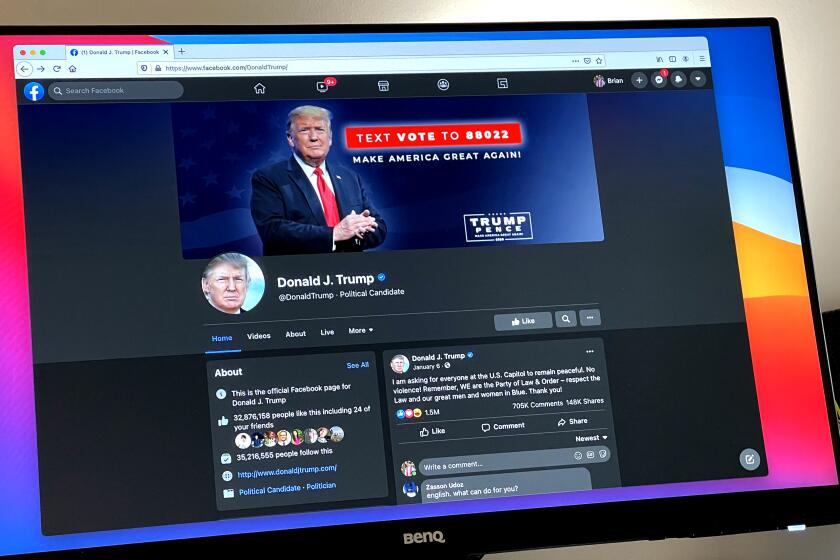Newsletters were supposed to be the Wild West. Enter Sheriff Google.
The newsletters business is booming, and Substack along with it. But one big thing still stands between writers and their readers: Google and its mysterious Gmail inbox filter.
- Share via
Over the last year, a gathering parade of writers — including some of the biggest names in journalism — have abandoned traditional publications for the greener, less centralized pastures of independent newsletters. The exodus has often been driven by frustrations with the various interlopers who stand between content creators and their audiences. Newspaper editors? Social media algorithms? No need to worry about these gatekeepers, the thinking goes, when you can just email your thoughts straight to whoever wants them.
It’s a trend that has made email sexy again, boosted earnings for a small cadre of name-brand writers and helped countless others supplement their incomes. The newsletter platform Substack has secured tens of millions in venture capital, while smaller-scale players such as Ghost and Buttondown have carved out their own niches in the emerging market.
Yet the dream of a middleman-free media ecosystem is not so fully realized as its proponents might like to think. There are still email providers to reckon with — in particular, Google’s free, wildly popular Gmail service.
Newsletter writers talk about Gmail and its whims “the way that Greeks used to talk about Greek gods,” said one writer, who publishes a newsletter through Substack competitor MailChimp. Like some ancient, unknowable deity, Gmail “has this influence over our lives, but we don’t know ... how they’re making decisions and how it will affect us from one day to another. We just know that it’s always changing, and sometimes it’s good news and sometimes it’s bad news.”
Nothing inspires this sense of helpless frustration more than Gmail’s Promotions folder: a sort of liminal purgatory into which the mailbox platform casts emails too bad for the inbox and too good for the spam folder. If the inbox is for friends, family and colleagues, and the spam folder is for untested virility pills and investment propositions from deposed foreign princes, the “Promos” folder is for … well, whatever Google’s sorting algorithm chooses to put there. For some newsletter writers, that seems to change week to week and reader to reader.
“There are people who get [my newsletter] in their primary inbox every single time, but there’s other people who maybe never ever got a chance to become a reader of the newsletter, because everything from their welcome email to their first 10 [issues] all went to the Promos folder,” said the MailChimp writer, who asked to remain anonymous for fear that deliverability issues would scare away his newsletter’s advertisers.
He estimated that between 5% and 10% of his Gmail-based subscribers never see a single thing he sends them. Falling into that gap is his own Gmail account, which he uses for troubleshooting. Despite engaging with every issue in the manner of an enthusiastic reader, the writer has never received his own newsletter in his primary inbox.
Gmail does let users deactivate this sorting system, but it’s enabled by default — something research suggests may nudge people to keep it turned on. Last year, the Markup raised concerns that this classification system inconsistently hurts politicians’ fundraising efforts. Even paying subscribers often see issues sequestered in their Promotions folders.
Kyle Merber, who writes a weekly Substack newsletter about track and field called the Lap Count, has struggled with similar problems. “People sign up for a newsletter … and they turn around one week later expecting to see it, and they don’t see it. So that obviously affects the open rate, and therefore your growth.”
Merber’s wife is among his subscribers, and although she receives the Lap Count on the same WiFi he mails it out from, Gmail continues to deposit each issue in her Promotions folder. She has tried every solution the internet hive-mind recommends: dragging-and-dropping new issues from Promotions over to the primary inbox; replying to the newsletter as if it were a real person; consistently opening and reading each issue.
“And yet still, for whatever reason, it continues to not populate in her inbox,” Merber said. “I know if this is happening to her, making all that effort, that it’s happening to a lot of people who haven’t maybe done that.”
He’s now thinking about leaving Substack altogether, perhaps to try his luck over at MailChimp.
A representative for Substack said the filtering problem “isn’t a significant issue” for the company. MailChimp declined to speak with The Times for this story. Ghost did not respond to repeated requests for comment. A representative for Twitter — which, in another indication of the medium’s rising relevance, recently acquired the newsletter platform Revue — said the company is too early in its “building phase” to discuss the issue.
The added friction of the Promotions folder not only frustrates writers but — in an industry with more and more money floating around — can also threaten their bottom line.
“A different company sponsors [the Lap Count] each week … and when I am negotiating those deals, it is through the lens of, ‘This is how many subscribers I have, and this is my open rate, and this is how many views it gets, and this is the click-through rate’ and all those numbers,” Merber said. “From a monetizing standpoint, having a better open rate is important.”
People sign up for a newsletter and they don’t see it. That affects your growth.
— Kyle Merber
Cordon McGee, who runs a small-scale meal prep business in Chapel Hill, N.C., has struggled with the same dynamic. “I’m absolutely sure that we have lost plenty of people because our reminder emails are going to a place where they don’t look.”
Although her newsletter, which lets customers know the company’s menu each week, is more in line with the business-to-consumer messaging that Gmail’s Promotions folder seems designed to quarantine, McGee says many of her subscribers ask her how they can get her messages to show up in their inboxes.
“If there was an option where they signed up [and] immediately when they clicked the button, ‘Would you like this to go into your inbox? Yes,’ that would be great,” McGee said. “But in the meantime, we just sort of deal with it.”
It’s a big enough problem that a cottage industry of “get my newsletter out of the Promos folder” services has emerged. Freelancers on the outsourcing platform Upwork brand themselves as email deliverability specialists; writers trade strategies on Reddit’s r/Newsletters, r/GMail and r/Substack forums. The MailChimp writer who views Gmail as a Greek god pays $80 a month for a service that gives his drafts a “deliverability score” and then suggests edits that’ll help it land in readers’ primary inboxes.
“It’s a lot of time and money that I personally spend doing that,” he said, “and I know a lot of other people do, too.”
Once ubiquitous on tweets and Instagram posts, the hashtag swooned in popularity as a result of overexposure. But a new crop of influencers finds it an indispensable tool.
With an estimated global market share of a little under 30%, Google isn’t the only company to provide a mailbox service, of course, but it’s the one that the newsletter writers whom The Times spoke with identified as their biggest frustration. Most other inboxes, they explained, only make a binary distinction between spam and not spam; but Gmail’s Promotions category introduces a new axis of discrimination, and one along which Google’s inconsistent, inscrutable decision-making can intercede between writers and readers.
Microsoft Outlook does offer a way to split inboxes into Focused and Other sections, but — perhaps because it’s often used in a workplace context — newsletter writers seemed unconcerned with it. Apple might soon become another problem thanks to a new Mail Privacy Protection service that’s set to limit what data email senders can collect about their readers, but industry insiders are split on how meaningful of a threat this is to newsletters. It will certainly make certain key metrics, such as a newsletter’s open rate, much harder to assess.
Google declined to comment in detail on these concerns, instead pointing The Times to a blog post explaining that the machine learning system that sorts emails into different folders looks at signals such as “who the email comes from, what type of content is in the message and how Gmail users have interacted with similar content” to divert “deals, offers, newsletters and other ‘call to action’ emails” into the Promotions folder.
That lumping in of New York Times staffers-turned-Substack entrepreneurs with H&M coupons and floundering Change.org petitions speaks to a broader issue. In a relatively short period of time, newsletters have gone from being borderline spam to being an important forum for journalism, and Gmail doesn’t seem to have noticed.
After years of debate around how and when social media should moderate user content, including frequent concerns about “shadow bans” that hide content rather than outright censor it, Gmail’s filtering system is a subtle form of moderation on a platform that rarely gets discussed in those terms.
It’s also an impediment to newsletters reaching their full potential, said Parthi Loganathan, chief executive of the smaller-scale newsletter platform Letterdrop.
“You’re adding so much friction,” Loganathan said. “It’s not simply: ‘Hey, here’s my email. I expect to see you in my inbox next week.’ It’s like: ‘Here’s my email. Read a bunch of texts, go open your inbox, search for it. Search through spam, search through Promotions. Move it to your inbox.’ Suddenly something which used to be a five-second commitment is now a five-minute commitment, and then you lose a bunch of people in that funnel.”
Frozen in time since the Jan. 6 insurrection, perhaps forever, Donald Trump’s Facebook page lives on as an internet destination for #MAGA fans and #Resistance types alike.
It’s an indication that newsletters aren’t quite the publishing Wild West that some hope (or fear) they’ve become.
“It’s still not perfectly decentralized,” said Buttondown founder Justin Duke. “If Gmail decides to go down a certain direction with their email filtering or email display knowledge — or Outlook, or any of the major four or five players — it’s not quite an oligopoly, but it’s still substantial enough that it has major ramifications.”
Duke said that over the last 18 months, at the same time Substack was blowing up and newsletters were going mainstream, he has seen some authors pivot yet again to an even further decentralized format: RSS, a web protocol that tracks website updates and compiles them chronologically to be read with one of various “RSS reader” applications.
“It still has its own issues, but you kind of get away from that risk of everything … only going through the email client,” Duke said. “RSS is sort of this looked-up-to hypothetical of, ‘Oh, God, wouldn’t the world be great if we were truly an open web and everyone really just built on top of these syndicated protocols.’”
RSS is still very niche, he added, but it recently got a vote of confidence from at least one big name in tech: Google, yet again, which plans to integrate RSS feeds into its Chrome browser.
“The irony of this, of course, is that’s Chrome doing it; so we are taking this open protocol and saying, ‘Oh, but as long as one of these very large behemoth browsers backs it, maybe that’s OK,’” Duke said. “This is one of the issues with the current incarnation of the web: wherever we try and flee to — in terms of a more decentralized, more open place — there’s inevitably going to be some sort of backing power structure.”
“I am hopeful that we do find a better way to manage these author-subscriber relationships in a way that is sustainable and isn’t ultimately accountable to a Gmail or some large provider,” he added. “But I don’t have a great sense of what that looks like in a way that’s going to scale.”






